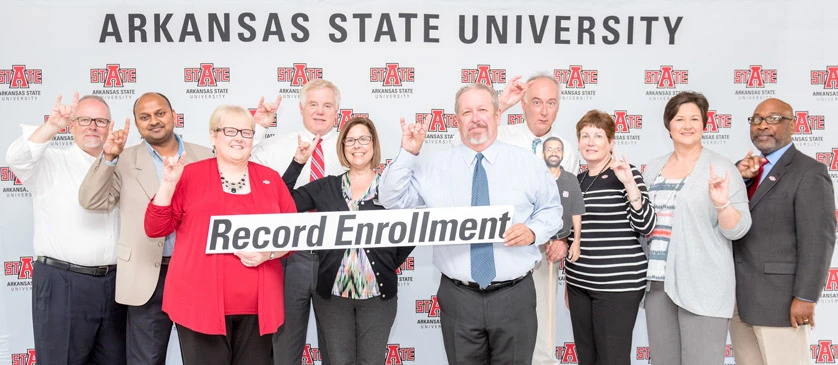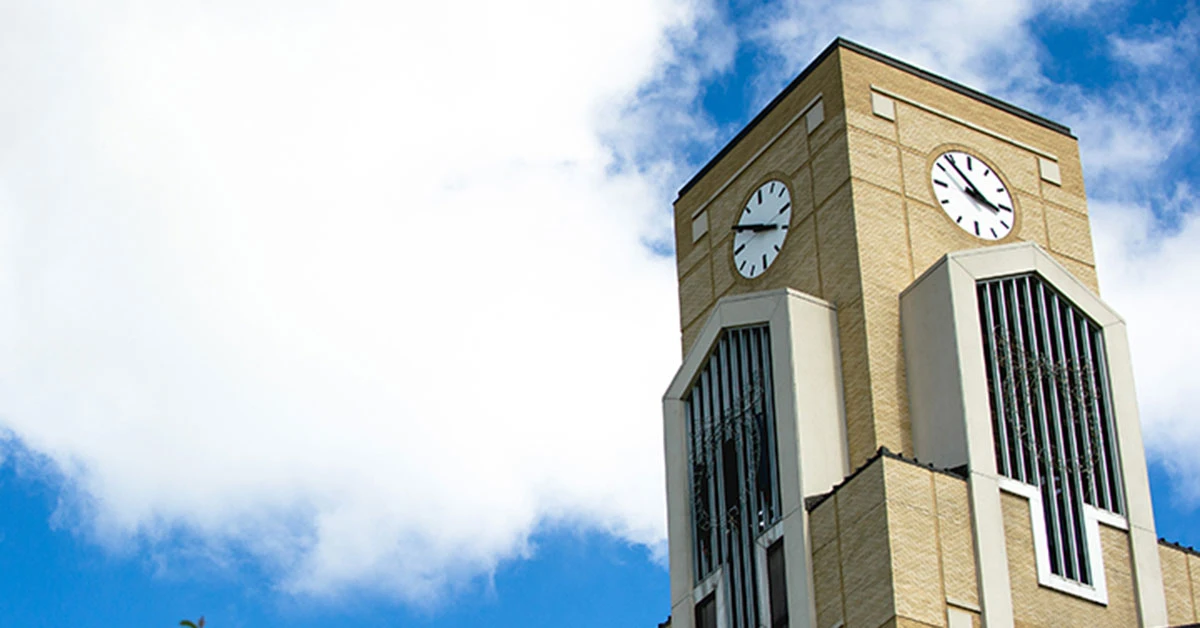A-State Reports Record Enrollment of 14,074 for Fall Semester
JONESBORO – Arkansas State University begins the 2016-17 academic year with an all-time record enrollment of 14,074 and growth of five percent over last fall. The state’s second largest university broke its previous record of 13,900 from 2011, a mark set prior to the installation of higher admission standards at the Jonesboro institution.
“This is a credit to our enrollment management team that has worked the past two years to create a strategy of steady, sustainable growth,” Acting Chancellor and Provost Lynita Cooksey said.
The record enrollment contained several other all-time marks including the largest graduate school enrollment, most international freshmen enrollment, largest online enrollment, most Hispanic enrollment and record out-of-state enrollment.
Arkansas State also scored a record for full-time equivalent enrollment with 10,096, just edging the previous of 10,095 from fall 2012. The number of FTE is a key state of Arkansas funding benchmark and is up 2.4 percent over last year.
“We are seeing growth in all parts of our enrollment profile,” Vice Chancellor Rick Stripling said. “Almost every way we look at our incoming class we saw an increase.”
Cooksey and Stripling co-chair the Enrollment Management Committee that began in fall 2014. Last year, A-State’s enrollment was up two percent to 13,410.
The number of traditional first-time, first-year students was up 4.6 percent to 1,649. They join the two previous classes as among the most academically qualified in school history. The composite ACT score of the incoming freshmen was 23.6, just shy of the record 23.9 in 2014. The composite high school GPA was 3.48, also just below the 2015 record of 3.51.
As important to the overall growth is the retention rate for students at Arkansas State. The university set a new record for two-year retention rate of full-time, first-time students with 65.3 percent. A-State also had a near record one-year retention rate with 74.9 percent, just off last year’s record 76 percent.
“Our mission to the state of Arkansas is to educate our population for the future challenges of our economy and to enhance their lives,” Cooksey said. “The increased admission standards at Arkansas State ensure we are bringing students to campus who are prepared for college. Our support structures are working to keep them here, and you see that with the higher retention rates.”
Over the past two years, Academic Affairs worked to put in place new programs to track student progress. The Starfish system allows faculty to interact with students during the course of the semester. Starfish is an integral part of enhancing the role of advising with specific academic disciplines and the development of specialized academic advising offices. The Learning Commons was built to bring into a single location the mentoring and tutoring services of the university within the Dean B. Ellis Library. One of A-State’s mainstay programs, the First-Year Experience, has seen significant revisions to improve the courses ability to transition students from high school to university-level academic work.
At the same time, Student Affairs enhanced and expanded on-campus programs to engage more students in university events.
“We know that students who live on-campus or take part in campus-based organizations have a significantly higher retention rate than those who do not,” Stripling said.
On-campus living has increased in popularity with returning students to the point the university entered into a public-private partnership earlier this year with Zimmer and Associates to expand on-campus housing by 500 slots for upperclassmen and graduate students.
This fall marked the first year of operation for the New York Institute of Technology’s College of Osteopathic Medicine. While NYIT is located in historic Wilson Hall, their inaugural class of osteopathic medical students do not count in A-State’s enrollment.
“NYITCOM is a separate academic institution,” Cooksey clarified for media today. “However, we do believe seeing their white coats around campus will impact our enrollment in the sciences as more students choose A-State as a pathway toward medical school.”
Arkansas State’s record graduate enrollment of 4,274 students comes as the institution completes a restructuring of its graduate programs, returning the administration of the individual disciplines back to their respective academic colleges. A-State also conferred a record 51 doctoral-level degrees during the past academic year.
The state’s largest online provider, A-State Online, also saw an increase in enrollment for the fall with final numbers completed during mid-October.
Within the university, one of the largest percentage growth areas was engineering. Over the past five years the program has grown 78.8 percent in semester credit hours and 80.8 percent in full-time equivalent enrollment, with the majority of the increase happening in the past three classes.
“What Dr. Paul Mixon has done since he took the lead of the engineering program is nothing short of phenomenal,” Stripling said. “Paul’s been a part of our enrollment management team and engineering has almost doubled in size.”
Over the past five years, College of Nursing and Health Professions ranked second in FTE with a 16 percent increase, followed by College of Agriculture and Technology at 13.5 percent.
Out-of-state enrollment grew to 2,825, besting last year’s 2,499, in part thanks to the Beyond Boundaries program that extends Arkansas State scholarship opportunities to residents in the nearby states.
“Traditionally Arkansas State has seen a significant number of students from the boot-heel region of Missouri as well as across the river in Tennessee and Mississippi,” Stripling said.
The preliminary count of students from Missouri is up 12 percent (667 to 747) and the number from Tennessee is up 12.9 percent (363 to 410).
With 128 international new freshmen, A-State surpasses the previous high of 89 set last fall. The number of students identifying as Hispanic increased to 350, also breaking last year’s record of 324. The number of men enrolled was 5,618, besting the 2012 mark of 5,465.
Other areas of significant growth included A-State’s concurrent high school enrollment grew 6.2 percent from last year.
Two years ago, Arkansas State welcomed one of its most academically prepared freshman classes, but saw overall enrollment drop to 13,135. This fall, A-State celebrates a record-breaking gain of almost 1,000 students since 2014.
Enrollment team members include (from left) Bill Smith, Mihir, Lynita Cooksey, Terry Finney, Jill Simons, Rick Stripling, Paul Mixon, Tracy Finch, Donna McMillin and Lonnie Williams.
Co-chaired by Cooksey and Stripling, the members of the Enrollment Management Committee over the past two years include Dr. Jason Penry, Vice Chancellor, University Advancement; Dr. Thilla Sivakumaran, Executive Director, Global Initiatives; Tracy Finch, Registrar, Admissions, Records and Registration; Terry Finney, Assistant Vice Chancellor, Enrollment Management; Donna McMillin, Assistant Vice Chancellor, Finance and Administration; Dr. Gina Hogue, Associate Vice Chancellor, Academic Affairs and Research; Beth Smith, Executive Director, ASU Alumni Association; Beth Silverthorn, Executive Assistant, Student Affairs; Dr. Paul Mixon, Dean, College of Engineering; Patrick Dixon, Director, Residence Life; Sarah Ponder, Administrative Assistant, Leadership Center; Henry Torres, Chief Information Officer, Information and Technology Services; Dr. Jill Simons, Dean, University College; Bill Smith, Executive Director, Marketing and Communications; Dr. Lonnie R. Williams, Associate Vice Chancellor, Student Affairs; Dr. Karen Wheeler, Assistant Vice Chancellor, Academic Affairs and Research; and Dr. Mihir, Assistant Vice Chancellor, Institutional Research, Planning and Assessment.


